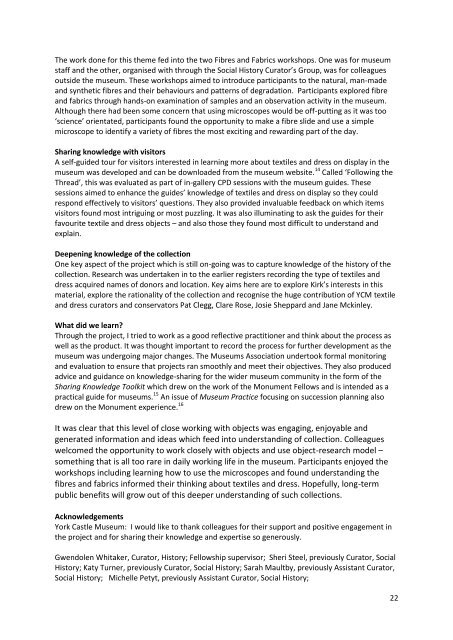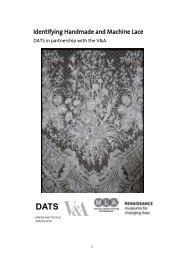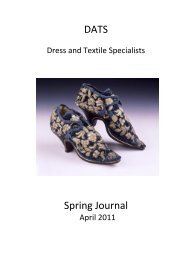Spring 2012 - Dress and Textile Specialists
Spring 2012 - Dress and Textile Specialists
Spring 2012 - Dress and Textile Specialists
You also want an ePaper? Increase the reach of your titles
YUMPU automatically turns print PDFs into web optimized ePapers that Google loves.
The work done for this theme fed into the two Fibres <strong>and</strong> Fabrics workshops. One was for museum<br />
staff <strong>and</strong> the other, organised with through the Social History Curator’s Group, was for colleagues<br />
outside the museum. These workshops aimed to introduce participants to the natural, man-made<br />
<strong>and</strong> synthetic fibres <strong>and</strong> their behaviours <strong>and</strong> patterns of degradation. Participants explored fibre<br />
<strong>and</strong> fabrics through h<strong>and</strong>s-on examination of samples <strong>and</strong> an observation activity in the museum.<br />
Although there had been some concern that using microscopes would be off-putting as it was too<br />
‘science’ orientated, participants found the opportunity to make a fibre slide <strong>and</strong> use a simple<br />
microscope to identify a variety of fibres the most exciting <strong>and</strong> rewarding part of the day.<br />
Sharing knowledge with visitors<br />
A self-guided tour for visitors interested in learning more about textiles <strong>and</strong> dress on display in the<br />
museum was developed <strong>and</strong> can be downloaded from the museum website. 14 Called ‘Following the<br />
Thread’, this was evaluated as part of in-gallery CPD sessions with the museum guides. These<br />
sessions aimed to enhance the guides’ knowledge of textiles <strong>and</strong> dress on display so they could<br />
respond effectively to visitors’ questions. They also provided invaluable feedback on which items<br />
visitors found most intriguing or most puzzling. It was also illuminating to ask the guides for their<br />
favourite textile <strong>and</strong> dress objects – <strong>and</strong> also those they found most difficult to underst<strong>and</strong> <strong>and</strong><br />
explain.<br />
Deepening knowledge of the collection<br />
One key aspect of the project which is still on-going was to capture knowledge of the history of the<br />
collection. Research was undertaken in to the earlier registers recording the type of textiles <strong>and</strong><br />
dress acquired names of donors <strong>and</strong> location. Key aims here are to explore Kirk’s interests in this<br />
material, explore the rationality of the collection <strong>and</strong> recognise the huge contribution of YCM textile<br />
<strong>and</strong> dress curators <strong>and</strong> conservators Pat Clegg, Clare Rose, Josie Sheppard <strong>and</strong> Jane Mckinley.<br />
What did we learn?<br />
Through the project, I tried to work as a good reflective practitioner <strong>and</strong> think about the process as<br />
well as the product. It was thought important to record the process for further development as the<br />
museum was undergoing major changes. The Museums Association undertook formal monitoring<br />
<strong>and</strong> evaluation to ensure that projects ran smoothly <strong>and</strong> meet their objectives. They also produced<br />
advice <strong>and</strong> guidance on knowledge-sharing for the wider museum community in the form of the<br />
Sharing Knowledge Toolkit which drew on the work of the Monument Fellows <strong>and</strong> is intended as a<br />
practical guide for museums. 15 An issue of Museum Practice focusing on succession planning also<br />
drew on the Monument experience. 16<br />
It was clear that this level of close working with objects was engaging, enjoyable <strong>and</strong><br />
generated information <strong>and</strong> ideas which feed into underst<strong>and</strong>ing of collection. Colleagues<br />
welcomed the opportunity to work closely with objects <strong>and</strong> use object-research model –<br />
something that is all too rare in daily working life in the museum. Participants enjoyed the<br />
workshops including learning how to use the microscopes <strong>and</strong> found underst<strong>and</strong>ing the<br />
fibres <strong>and</strong> fabrics informed their thinking about textiles <strong>and</strong> dress. Hopefully, long-term<br />
public benefits will grow out of this deeper underst<strong>and</strong>ing of such collections.<br />
Acknowledgements<br />
York Castle Museum: I would like to thank colleagues for their support <strong>and</strong> positive engagement in<br />
the project <strong>and</strong> for sharing their knowledge <strong>and</strong> expertise so generously.<br />
Gwendolen Whitaker, Curator, History; Fellowship supervisor; Sheri Steel, previously Curator, Social<br />
History; Katy Turner, previously Curator, Social History; Sarah Maultby, previously Assistant Curator,<br />
Social History; Michelle Petyt, previously Assistant Curator, Social History;<br />
22





